Archis Mohan
BJP's master strategist Amit Shah made the Uttar Pradesh unit battle-ready in less than a year.
Archis Mohan reports
Amit Shah, the Bharatiya Janata Party's Lok Sabha elections incharge for Uttar Pradesh, has turned a moribund state party unit into a battle-hardened machine in less than a year.
The party's top leadership is convinced Shah has also succeeded in striking a fine balance between spreading BJP's complex political discourse of development and Hindutva, while at the same time adeptly adjusting to the requirements of the state's caste-based politics.
Shah, who often tweets on how no power could defeat a man who has conquered himself, has somehow managed to get the party's rank and file on his side within months of being made the UP incharge.
People who have worked with him over the past year say Shah is extremely patient and has an ability to look beyond himself for the party's interest. That makes him the ideal strategist for a difficult state like Uttar Pradesh.
Shah displayed some of these qualities last week when the Election Commission barred him and Samajwadi Party leader Azam Khan for their alleged hate speeches. Initially, BJP doubted the veracity of the video recordings of Shah's speeches and challenged the order. But, according to sources in the party, Shah disagreed with that approach.
...
Understanding the Amit Shah phenomenon
On April 14, within three days of the notice, Shah told the Election Commission he would be careful about his utterances in future.
The panel lifted its ban on Shah a couple of days later, enabling him to continue campaigning in UP as the election entered a crucial phase. But Khan is still out of action.
"Koi bowler bowling karta hai toh no-ball ho jati hai (if a bowler bowls, he could overstep sometimes)," Shah tweeted later.
Shah is now heading for the important battlegrounds of central and eastern UP, which go to polls in the remaining four phases.
These are areas where BJP has not fared well in the past decade.
A couple of days ago, Shah asked his followers to "not rely on positive opinion polls or a wave. Keep working till the last vote is cast for BJP".
...
Understanding the Amit Shah phenomenon
Rewind to last year, when Shah was made the prabhari for Uttar Pradesh in June 2013.
Many in the party had doubted his ability to revive the state unit.
The portly bespectacled man, whom the Supreme Court had earlier sent "tadipaar" from Gujarat -- that is, barred his entry in the state for his alleged role in three cases of fake encounters as the junior minister for home affairs in Gujarat -- had inspired little confidence among the warring leaders of BJP's Uttar Pradesh division.
"UP is no Gujarat," many said.
Now, a year later, Shah's name evokes fear -- within the party, as also among rivals.
BJP claims Shah, with support from party president Rajnath Singh and guidance from the unsung former UP chief minister Kalyan Singh, has galvanised the party in a matter of months.
...
Understanding the Amit Shah phenomenon
In one of his first moves, Shah had taken up the task of cleansing the party unit's membership data.
This not only helped revive contacts with several forgotten workers but exposed the claims of the existing leadership, which had been artificially swelling the numbers by making fake members.
Shah systematically cut such leaders down to size, giving an opportunity to younger members. Karunesh, a leader coordinating Modi's campaign in Varanasi, is one such member handpicked by Shah.
"I admire his ability to patiently listen to all and sundry, from the lowliest of workers to senior leaders," Karunesh says.
That Shah is becoming larger than life is evident when workers tell you the man from Gujarat hasn't lost even one of the 28 elections since 1989 (both state Assembly and urban local bodies) he has fought or strategised for his party in.
Party sources credit Shah with first mooting the idea that Modi should contest from Varanasi. It was a proposition that appealed to many.
People understood how Modi contesting from Varanasi would influence many in other eastern UP constituencies, as well as some seats in neighbouring Bihar.
...
Understanding the Amit Shah phenomenon
BJP supporters and party workers across UP, the most important swing state in the elections this time, are convinced the party has left its bad days behind. Most credit the turnaround to Shah, Modi's "senapati" (field marshal).
"BJP has turned a corner in UP. It is no more a challenge to win most of UP's 80 seats in the 2014 Lok Sabha elections. The goal now is to win the 2017 Assembly election," says Devabrata Choubey, a professor of philosophy at the Banaras Hindu University.
The Shah strategy has focused on asking the party election committee to give more tickets to non-Yadavs among OBCs (other backward classes) and non-Jatavs among dalits.
It has also included striking electoral tie-ups with such small parties as the Apna Dal in eastern UP. Shah and Kalyan Singh pushed BJP to sacrifice two Lok Sabha seats of Muzaffarnagar and Pratapgarh to that party, which represents Patels (Kurmis) in eastern UP.
The party expects most of these castes to vote for the BJP candidates, instead of Mulayam Singh Yadav's Samajwadi Party or Mayawati's Bahujan Samaj Party. Shah has been telling non-Jatav dalits to teach Mayawati a lesson for ignoring them and giving more tickets to Jatavs and Muslims. Party sources say Shah and Kalyan also convinced the party to admit dalit leader Udit Raj to send a message across UP's dalits that the party had their interest at its heart.
...
Understanding the Amit Shah phenomenon
So, in the Awadh area the party followed a strategy of looking at non-Jatav dalit vote bank of Mayawati's BSP. It fielded 'pasi' candidates in scheduled-caste reserved seats of Misrikh, Hardoi, Mohanlalganj and Barabanki. BJP also reached out to non-Yadav OBC castes like Kurmis, Lodhs, Kushwahas, Kashyaps, Rajbhars and Baghels, besides Jats in western UP.
The strategy has also included identifying winning candidates from other parties. For example, Jagdambika Pal was admitted from the Congress and fielded from Domariyaganj. Brij Bhushan Sharan Singh, S P Singh Baghel and Dharmendra Kashyap were brought from the Samajwadi Party and fielded from Kaiserganj, Firozabad and Aonla, respectively.
These decisions were made despite protest from the party's district units. In Western UP, BJP fielded Hukum Singh from Kairana and Sanjeev Baliyan from Muzaffarnagar, in spite of allegations that they were involved in fanning the communal riots of September 2013.
Not everybody, though, is convinced that there is anything new in Shah's strategy for UP.
Ramesh Dixit, a former Lucknow University professor, says some of the non-Yadav OBCs and and non-Jatav Dalits have traditionally been BJP supporters.
"All this about Amit Shah being a great strategist is spin-doctoring to rehabilitate in public perception a person facing criminal charges," he says.
Dixit, who has been a former Congress activist, says election strategy is not some esoteric science. "It is not rocket science as it is being made out to be. All parties have election strategists who know caste combinations in each constituency, names of winning and losing candidates and the margins of elections from 1937 onwards," he says.
...
Understanding the Amit Shah phenomenon
Dixit says the only purpose of fielding Modi from Varanasi is to polarise the votes between Hindus and Muslims, which in western UP was accomplished through the Muzaffarnagar riots.
Observers like Dixit point out that BJP has tried social engineering in the state since 1996. It has had leaders like Uma Bharati and Kalyan Singh, both from the Lodh caste.
The party has had the support of the Gangwar caste in the Bareilley region. Pasis have supported the Jana Sangh since 1952. Hardoi, where the community is dominant, returned a Jana Sangh MP as early as 1957.
"They don't have candidates. Discards are being imported from other parties and it is being termed election strategy," Dixit says.
The Shah-Kalyan team has been helped by Rameshwar Chaurasia, Satyendra Narain Kushwaha, Hriday Nath Singh, Captain Abhimany and Trivendra Singh Rawat.
It has roped in students in larger numbers to campaign for the party -- as many as 7,500 students in Varanasi are canvassing for BJP.
Shah has visited as many as 62 districts since June and activated the synergy between the Rashtriya Swayamsevak Sangh and BJP. Some of the tasks like booth-level committees for each of the 128,000 booths has been given to RSS. He has also devised a detailed campaigning strategy and the nature of advertising, including 401 'raths' or trucks sent to 403 Assembly constituencies to play Modi's speeches.

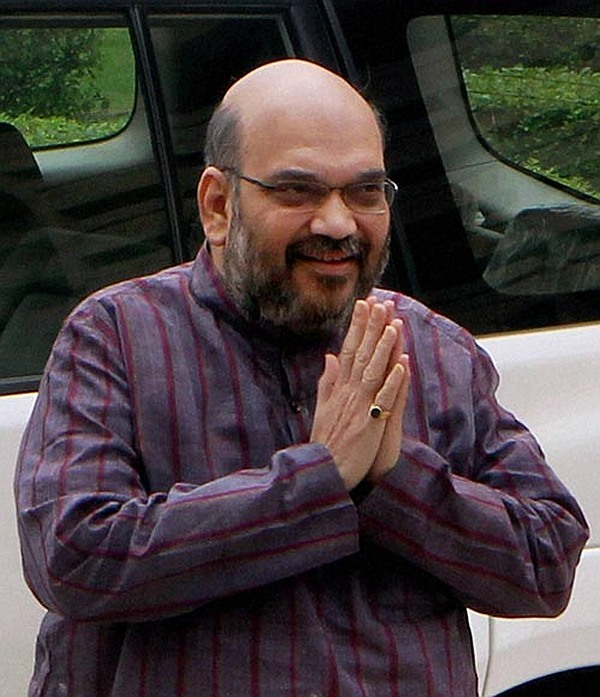
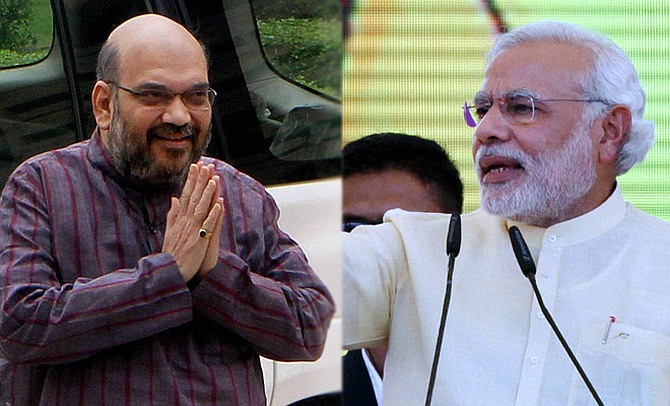
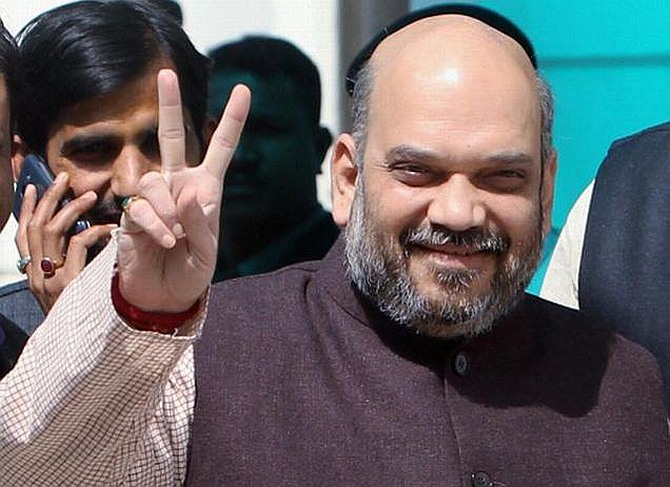

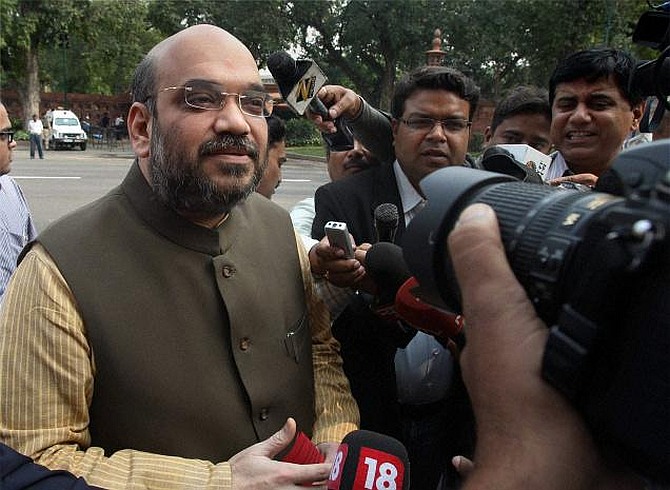

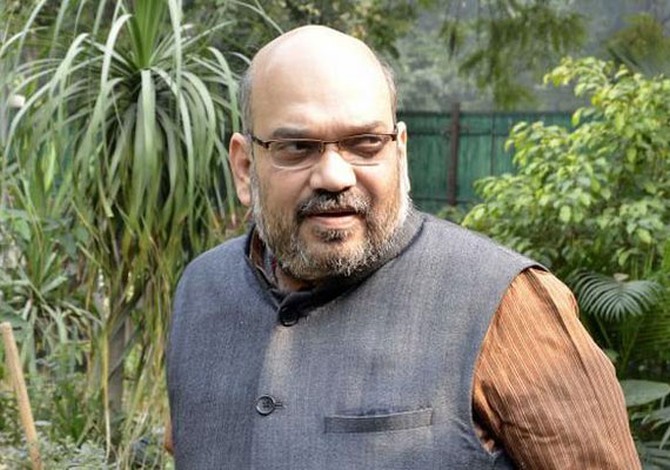

article